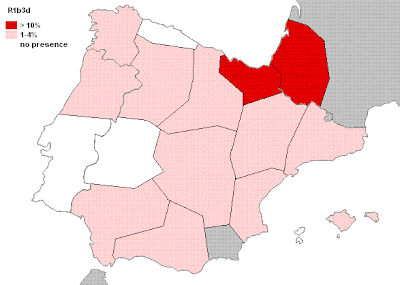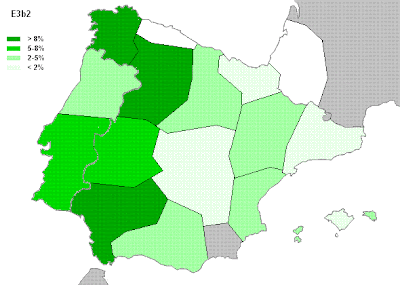Found the reference to this interesting Y-DNA study at Dienekes. The paper itself, by Adams et al., is behind a paywall, but curiously enough the supplemental material is not. And there is where all the hard data is anyhow.
It's maybe one of the most comprehensive Y-DNA studies of Iberian (and Gascon) populations. After some work, I got the following distribution maps:
Haplogroup R1b.
Nearly all R is R1b, with some R1b* at Valencia but mostly R1b3 (really old nomenclature, I know, but it's what the paper uses and does not mention the specific SNPs, so I'm follwing it here, much to my own displeasure). There's also some scattered R1a1 and even one R1* in Western Andalusia.
Within R1b3 most is R1b3* (if anybody is willing to compare the haplotypes, that would be an interesting thing to do and I'd love to hear from the results - overall, on first sight, they appear rather closely related anyhow). There are three SNP-defined subclades though:
- R1b3b, only found in the Basque Country (2 individuals)
- R1b3d, clearly stronger among Basque and Gascons and less important elswhere
- R1b3f, centered in Catalonia (other studies suggest Mid/Eastern Pyrenees) and somewhat more common in the peninsula, specially in the East


 R1b becomes somewhat rarer to the SW but it is also oddly low in Asturias and Aragon. These two regions show some peculiarities regarding other clades too, what suggests that they have been affected by major demic movements at or after the Neolithic.
R1b becomes somewhat rarer to the SW but it is also oddly low in Asturias and Aragon. These two regions show some peculiarities regarding other clades too, what suggests that they have been affected by major demic movements at or after the Neolithic.Haplogroup I.
Neolithic or Celtic or both? Lacking clear data on what subclades are more common in each region is hard to judge. Overall other studies have suggested that the Iberian main clade is the same as that of the Balcans, what would suggest a Neolithic origin (Cardium Pottery) but hard to say without testing downstream SNPs.
Haplogroup I in Iberia is strongest at Aragon (a major Celtic hub in the Iron Age) but other locations appear to relate better with a Neolithic spread. The high presence in Galicia, Asturias and Extremadura could be explained by both prehistorical migrations.

Haplgroup E3b (now E1b1b).
While there are some E3b*, some E3b3 and even some E(xE3b), two clades appear dominant: E3b2 and E3b1. Not sure which is which (this nomenclature went obsolete long ago) but I think one correlates best with Greece/Albania and the other with North Africa. Nevertheless their distribution patterns are very similar, being both strong in the West specially.
Out of the Western Half, Valencia and Minorca appear significative in the East, what may relate to Neolithic founder effects.


Haplogroup J2.
While here is some scattered J(xJ2), most of the Iberian J is J2. This is a clearly Neolithic clade too, that must have originated in the Eastern Mediterranean, arriving with Cardium Pottery.
It's widespread but again the West (specially the SW, but also the enigmatic Asturias) appears unusually high.

Haplogroup G.
This is another clade that must be original from West Asia (Neolithic). It appears strongest in Portugal and overall in the West. There are other areas, notably Catalonia, where this clade is also very important.
 Haplogroup T.
Haplogroup T.Described as K(xP), this clade must be T (formerly known as K2). It must be again a Neolithic clade and is strongest in Ibiza (Phoenician founder effect?).

And that's about all. Just to mention the two cases of Q(xQ3), found one in the Basque Country and the other in Andalusia that must be considered erratics of likely Anatolian origin (Neolithic).
Hope you like the maps.










6 comments:
Hope you like the maps.
Maps look good. But in my case, a single map (with the names of the provinces) and histograms/pie charts are more helpful. These kinds of maps are helpful when you consider continents together.
Well, I did my best, making pie charts is right now somewhat more complicated and, anyhow, I wanted to see the patterns for each individual clade.
For the names of the regions, you may find them in any political map of Spain (Gascony and Portugal excepted, obviously). For instance the one available at Wikipedia. Some regions used by the authors nevertheless do not correspond with actual political divisions: Andalusia is split in two (east and west), the Balearic Islands in its three major isles, while the exact borders of NW and NE Castile are not actually known to me and have been drawn somewhat arbitrarily.
Yes. I like thas maps. Very well done, Maju.
Thanks. Glad that someone likes them.
This "raw data" is useless.
You see, it is the first and only study that presents - not a 10% North African clades in Iberia - some 20% Middle Eastern / Eastern Mediterranean clades in Portugal and Spain while all the other studies have shown around 5% (maximum 8 or 9, never 20%).
If someone knows another study where Spain is 20% Middle Eastern, as if Greece or Southern Italians we were... with such massive alien influences... please present it to me here. Thanks you.
And meanwhile: Down with ETA!
Where do you see 20% "North African" clades? I see some over 8% in NW Iberia and that's it.
If someone knows another study where Spain is 20% Middle Eastern.
Absolutely yes. Check Bauchet 2007, possibly the most comprehensive research on European autosomal DNA to date (even if it has some shortcomings too). Following this paper, Spaniards have certainly more than 10% Eastern Mediterrenaean ancestry overall (Y-DNA is not reflective of overall ancestry, just male-mediated ancestry) but, more interestingly, they make up a cluster on their own, distinct from Basques and also from Central-North Europeans.
Basques also make up a distinct cluster, apart from Spaniards.
...
And regarding your political comment, all I can say is why do you even care: are you Basque? If not, please abstain of meddling in our sovereign political problems. Down with Spain: jail of peoples!
Post a Comment